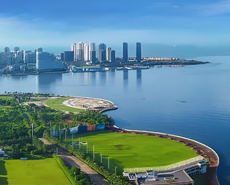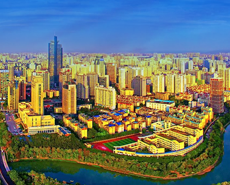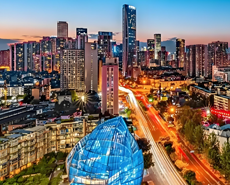Tin market to improve in 2016 supported by tight supply for raw material
----Interview with Huang Xueyou, General Manager of Nanshan Tin
As a company about recycling economy and comprehensive utilization of renewable resources in Nankang, Ganzhou, Jiangxi Nanshan Tin Co., Ltd. (Nanshan Tin) is a large private company, integrated with metallurgy, processing, energy safety, environmental protection and trading. With the floor space of 85,000 square meters and the covered area of 28,000 square meters, the company was invested RMB500 million in total, including over RMB40 million in environmentally protective facilities. Using tin as raw material, Nanshan Tin’s annual capacity for refined tin reaches 10,000t and annual production value is over RMB1 billion, paying more than RMB30 million of taxes per year.
Asian Metal: Mr. Huang, thank you for accepting the interview of Asian Metal. Could you please give us a brief introduction about the main business of your company?
Huang: Jiangxi Nanshan Tin was registered in 2001 in West Zone of Longling Industrial Park, Nankang, Ganzhou. The company mainly deals with tin ingot 99.95% and 99.9% of GB/T 728-1998, tin ingot 99.5%min, crude ingot and other products, and owns production lines of fuming furnaces, electric furnaces, vacuum furnaces for refining, electrolysis, pre-handling and environmental protection.
Asian Metal: Though tin prices have picked up slightly in SHFE and LME so far in 2016 after the continual decrease in 2015, most Chinese tin smelters continue to note that their profits are very slim. How about your profits in tin ingot production?
Huang: Without clear market direction, smelting plants will inevitably have survival problems. We just open an electric furnace at present with a monthly output of over 400t. In addition with difficulties in purchasing raw materials, our profits are also limited.
Asian Metal: China has carried out the reform of supply front since 2015 and major tin companies has also released joint statement of reducing tin ingot output by 17,000t in 2016. Will you reduce production? How about the effect of the joint production reduction on market development?
Huang: China produces 140,000-150,000t of tin ingot per year, including 110,000-120,000t from tin ores and 30,000-40,000t from recycling secondary materials. Chinese market sees 10,000t of extra supply for tin ingot per year at most, which doesn’t mean oversupply strictly speaking. The joint production reduction merely reflects that smelting plants are eager to support the price to rise, but actually it’s hard to realize. In accordance with the planning proposal of Nankang government, Nankang focuses its development target of 13th Five Year Plan in industry from 2016 and will double production value in three years. Thus, we will bear great pressure if we reduce production.
Asian Metal: What’s the biggest challenge and advantage in your company in the near future?
Huang: Generally speaking, the biggest problem for manufacturing companies is about fund. Having gradually canceled bank loans since 2004, we basically stand no pressure of debts. The biggest problem for us is in purchasing raw material. The purchasing mode of raw material has changed now. We used to purchase tin ore directly from mines in Jiangxi and Hunan with fixed and safe transaction mode, but now we have to import tin ores as nearly 80% of domestic tin mines have halted production. Affected by this, we are in negative position in purchasing with unstable supplies. At the same time, we face more risks now in purchasing raw material as we have to pay in advance. As for our advantage, it is about the local policy. Ganzhou is actively developing industry now and the cooperation between government and companies becomes closer and closer.
Asian Metal: The first quarter of 2016 has passed already. what do you think of the demand for tin ingot in the Chinese market in 2016 in terms with transactions?
Huang: In my opinion, the demand always exists in the market and the key problem lies in the confidence toward the market. As Wen Jiabao, the former premier of China, said, confidence is more important than gold. Compared with 2015, we hold a more optimistic attitude towards the market condition of 2016 and thus we think the tin market will be better than last year. Besides, the usage of tin is very wide with fewer replacing materials.
Asian Metal: Tin price continued to fluctuate below RMB120,000/t in the domestic market generally in the first quarter of 2016. What do you think of the price trend of tin throughout the year?
Huang: Tin belongs to minor metals and the market is very small. Moreover, as tin appears in SHFE, it’s early to decide tin price in the spot market as it will be influenced by macro-control policies in the near future. Seeing in the long run, the price trend of tin will be decided by the relationship between supply and demand. As for the supply of raw material, due to the tight supply for tin ore, over 80% of mines are closed and the production cost for tin ore 0.2%min is about RMB90,000/metal ton VAT excluded. Though the price for Burmese origin tin ore is lower than the expectation at present, the production cost will increase and the export will inevitably be limited in the future. If Burma bans the export of tin ore, Chinese producers will resume production in 2-3 months at least, when tin price will possibly increase to RMB200,000/t. Having experienced the bad market condition in 2015, market participants become more confident in perceiving the market with more psychological enduring abilities. Thus, generally speaking, tin price will be about RMB100,000/t with more supports from downstream market.
Asian Metal: What’s the development direction for Nanshan Tin in the future?
Huang: According to the Government Work Report of Nankang in 2016, Nanshan Tin, Kaiyuan Mining, Jinlong Mining will speed up the retreat from the urban area to industry zones and improve technology and additional value of product. We are preparing for relocation and technology improvement now and will possibly do business in new offices in 2018. Under the leadership of local government, we have made a lot of progress in grasping good opportunities and technology improvement. From now on, we will continue to work under the principle of destocking, insist on limited loans or no loans at all to make Nanshan Tin stronger and stronger.
















